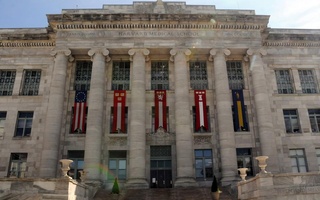After years of planning, Harvard Medical School this fall launched a formal initiative to integrate the arts and humanities into the traditionally hard-sciences focused campus in an effort to cultivate more empathetic medical professionals.
The “Arts&Humanities@HMS” initiative— planning for which began in 2011— supports the arts in part by raising money to create fellowships for Medical School affiliates interested in the intersection of art and medicine. The initiative also looks to create more opportunities for students to explore music, visual arts, and drama by hosting events, including case narrative readings and performances by the Longwood Symphony Orchestra. {shortcode-97dc264634e0a037a245eede6aa04c3f987576fe}
The initiative, which the school approved in June, comes at a time when universities across the nation are reimagining medical education as a more holistic growth process. For example, increasing numbers of students are taking gap years before medical school to reflect on their goals. And this fall, the Medical School rolled out a drastic overhaul of its curriculum, which focuses on “active learning” teaching methods like flipped classrooms.
Students and faculty alike have already expressed interest in increasing the number of arts-based offerings at the school. A 2012 survey of Medical School affiliates indicated that “there are over 1,000 people who are interested in the role of arts and humanities in medicine,” according to professor David S. Jones, who has helped lead and donated to the arts initiative.
Jones said studying humanities will help aspiring doctors better relate to their patients.
“All the doctors who are involved in the arts will say [that the arts] make them better doctors,” he said.
Prior to the launch of the Medical School’s new initiative, the arts and humanities had already occupied an informal presence on campus, according to Ronald A. Arky, a professor there who has been involved with medical education for more than 20 years. For example, he said, a decade-old elective course “Training the Eye” offers first-year medical students the opportunity to critique art and apply those skills to a clinical setting.
“Even back in the 1980s, I’ve actually participated with students in visiting the Museum of Fine Arts, or museums in Cambridge, and so forth,” Arky said. “It’s been there, but needed to be brought to the fore.”
Currently, Jones said, he and others involved in the initiative are trying to gauge student interest to best tailor the arts to the Medical School. Ultimately he hopes to “foster a more artistically inclusive community” and curb the notion that, especially at Harvard, the arts and medicine are mutually exclusive.
“Students say they feel like they have to turn the humanities part of their brain off when they come to HMS,” Jones said. “One of our goals is to make sure that no one at our medical school ever says that again.”
—Staff writer Melanie Y. Fu can be reached at mfu@college.harvard.edu. Follow her on Twitter @MelanieYFu.
—Staff writer Jiwon Joung can be reached at joung@college.harvard.edu. Follow her on Twitter @YunaJoung.
Read more in University News
Ta-Nehisi Coates Talks Race Relations at JFK ForumRecommended Articles
-
Gawande Juggles Pen and ScalpelFrom the Harvard Medical School (HMS) Quad to the White House lawn, Atul A. Gawande has tried his hand at
-
Pathology Professor Goldman Gets PrizeHarvey Goldman, a professor of pathology at Harvard Medical School (HMS) since 1960, was presented with the Distinguished Pathologist Award
-
 Medical School Raises $467 Million in Capital Campaign
Medical School Raises $467 Million in Capital Campaign -
 At Medical School, New Curriculum Met With Praise
At Medical School, New Curriculum Met With Praise -
Law School Dean Emphasizes Mediation for Bioethical IssuesAt a lecture Thursday, Harvard Law School Dean Martha L. Minow emphasized the benefits of resolving bioethical issues through mediation, rather than litigation.













